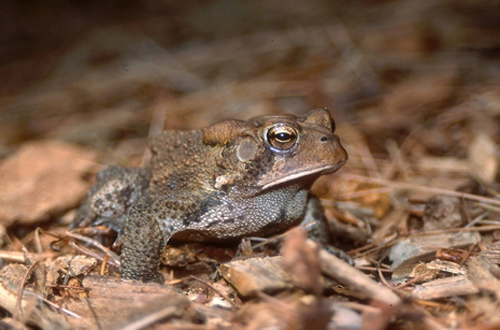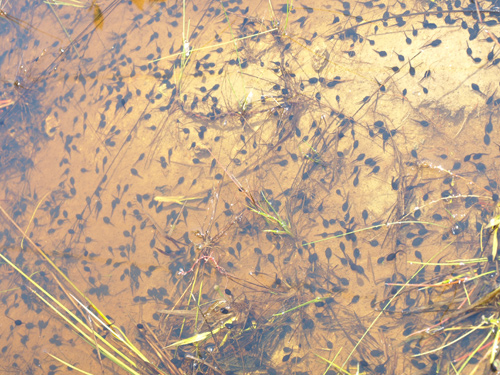The American toad is squat with dark brown, grey, greenish or brown coloration. Its skin is warty and bumpy. Males have a dark-colored throat while female toads have lighter throats. Toads have two kidney-shaped, raised parotid glands just behind their eyes that contain toxins. American toads can be 2 to 4 1/2 inches long.
American toads range through most of the eastern part of the US, except for the most southern states, and live in southeastern Canada. They are found throughout Connecticut and frequent moist areas in forests, fields and residential areas. Adults live on land, but return to shallow pools to breed and lay eggs. Tadpoles live in the water until they reach maturity. Toads are active during the warm season and shelter for the winter in an underground burrow. They are most active overnight although during breeding they may be active day and night.
Adult toads are insectivores and hunt bugs by shooting out their sticky tongue to trap an insect and draw it back into their mouth. American toads eat all sorts of insects and earthworms. Immature toads, tadpoles, feed on plant matter.
Mating season peaks in late April. Males emerge from their burrows and head to wet areas with shallow water to sing mating calls and find a mate. They aren't particular and will latch onto anything that looks toad-like including other male toads and other species. A male grabs the female around her chest with his front legs and clings until she lays her eggs in the water. He deposits sperm on top of them. It is common for toads to mate and lay eggs in the shallows of larger bodies of water, in temporary spring pools (vernal pools), or in rainwater-filled ruts. Toad eggs are produced in long jelly-like strings. Individual eggs can be seen dotting the length of the string. In a few days the eggs hatch into small black tadpoles. It takes about 4 to 6 weeks for the tadpoles to absorb their tails, grow legs and develop lungs, at which point they leave the water and hop off to begin life on land.
Toads are solitary, except when they congregate in shallow pools to breed in the spring. Toads may not be physical beauties, but they have lovely trills for singing voices. One may hear toads in the spring more often than seeing them, and the songs made by males during the breeding season are charming. Click the toad call link in between the photos for an example.
Male toads produce their trills by inflating part of their mouth lining under their throat with air through an opening in the bottom of their mouths. They then close off their mouths and nostrils and pump air between their lungs and this vocal sac over their vocal chords. The vocal sac of a calling male toad is clearly visible as a bubble under his throat. The darker coloring of a male toad's throat is because of the existance of this vocal sac.
Toad defenses include the propensity of a toad being handled to produce dark brown urine. They will puff up their bodies with air to seem larger. In addition, the toxins in a toad's parotid glands just behind their eyes produce a substance that tastes bad, can irritate the mouth and cause nausea. Few predators will eat American toads. Raccoons, skunks and snakes are among the few who prey on them.
Neat Facts
Male toads produce a special release chirp used to inform another male toad who has grabbed them that they have mistakenly latched onto another male.
One cannot get warts from handling toads, although one may get urinated upon.

